The feeding of ruminant livestock in many countries of the world is dependent on readily available low quality roughages or crop residues. In poorer countries that are densely populated, opportunities for supplementing these animals with products such as cereal grain, urea or molasses are limited. In addition, production systems in these countries are typically small but intensive, with one family often owning only a few head of livestock. In such situations, cattle may provide milk for the family, or draft to prepare the soil for planting and reproduction to produce replacement animals. Poor quality roughages such as rice straw have low digestibility and only move slowly through the rumen. As a result intake is also low and digestible energy intake (feed intake multiplied by digestibility) is also low, so production is limited. Strategies aimed at improving the quality of low quality roughages are therefore needed.

Physical treatment of roughages
There are various ways in which the physical characteristics of roughages may be altered to improve digestibility and/or intake. These include grinding, chopping and pelleting. These methods can be considered in four categories:
- Particle size: reducing particle size in order to increase the surface area for microbial fermentation of fibrous components in the rumen or hind gut or to expose more of the material to pre–feeding treatments;
- Handling: to produce a material that is easier to handle or compact during the processes of ensiling or storage;
- Density: to increase the density of the material so that animals are able to increase their intake; and
- Mixing: in order to mix other ingredients with the roughage to balance the nutrients supplied to the animal and improve the animal’s ability to digest the fibrous material and/or consume more of it.
Roughage Processing Method
A. Dry processing method
- Grinding
- Chopping
- Bailing
- Pelleting
- Cubing
- Dehydration
B. Wet processing method
- Green Choping
- Soaking
Grinding to reduce particle size
Roughages are usually ground before they are pelleted, size of the pellets range from 12/64″ o 48/64″ (4.8 mm to 19.1 mm). Pelleted roughages weigh about 40 lb/cft as compared to 5-6 lb/cft for long hay. Pelleting poor quality roughages will markedly increase the consumption of roughage. In palletizing complete feeds incorporation of concentrate mixture at 30% level appear to be the upper limit for optimising the feed intake; otherwise feed intake is decreased. Feeding pellets particularly with a higher concentrate content to ruminants may cause parakeratosis- a degeneration of the rumen papilla. That is pelleting of diets low in forage has an adverse effect.
Grinding of roughage is a prerequisite for mixing and pelleting. These mechanical processes increase voluntary intake, nutritive value and facilitate preparation of complete feed. Roughage should be ground to 1-2″ (2.5-5 cm) long for roughage feeding alone or from 0.5 to 1.0″ (1.3-2.5 cm) when it is to be incorporated in complete rations. The dust loss can largely be prevented by addition of 1% tallow or water to the material at the time of grinding. Addition of molasses to ground hay makes it highly palatable and increases feed intake.
Effect of Grinding Roughages
- Feeding of ground roughage reduces rumination and rumen retention time. Feed consumption is increased leading to better animal performance.
- Fine grinding of roughage usually reduces digestibility of crude fibre due to faster rate of feed passage. Feeding finely ground feed to dairy animals result in a lower butter fat content in the milk due to lower rumen acetate production.
In view of the cost of equipment, ever increasing cost of energy for running the equipment and transportation of straw to the feed plant and back to the farm, this method appears to be not feasible at farm level and questionable at commercial scale. Grinding of low quality roughage increase the dry matter digestibility compared to high quality one. It is recommended that straws/stovers be chopped or coarsely ground prior to feeding.
Although this is one of the simplest mechanical processes in the treatment of any feedstuff, it is still an expensive and relatively unpleasant task. The efficient handling of the large quantities of roughage requires expensive mechanization and the process of grinding uses large quantities of energy. Even in large efficient operations the cost of grinding hay or straw is estimated to be over $20/tonne.
In addition to the cost is the unpleasant working environment involved in the grinding operation. It is invariably noisy and dusty. Operators are therefore required to wear protective equipment to limit the damage to hearing and the inhalation of dust. The question is therefore whether it is a process that is cost– effective when all of these factors are considered. There are clear benefits in terms of increased digestibility of fibre via microbial fermentation as the particle size is decreased in both roughages and grains. It is unlikely that the increased digestibility alone pays for the cost and irksome nature of the task in grinding hay or straw. Even in situations where feed intake and live–weight gain are increased as a result of grinding, benefits in terms of feed conversion efficiency are rarely achieved. Where the quality of roughage is very low, grinding normally has little if any effect on intake and animal performance. However, in the preparation of completely mixed rations and pelleted diets, it is essential to break down the particle size for effective mixing and/or pelleting.
Baling
It is one of the most common methods used to increase convenience of handling forage. The forage is cut and permitted to dry in the field. Dried forage is the baled with a stationary or field baler. It is very popular in developed countries.
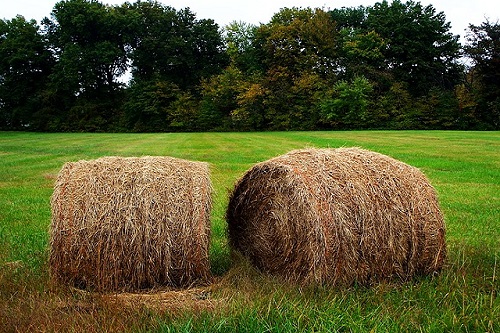
Pelleting and cubing
Cubing is modification of wafer production. Density of long hay is 7 lb/cft while density of cubed hay and density of pelleted hay are 25-32 lb/cft and 40 lb/cft, respectively. At the time of cubing the hay is broken rather than ground. So there is minimum of fine particles in the cube. Most of the cubing is done with excellent quality alfalfa hay. At the time of cubing water is sprayed on the hay to raise the moisture level to about 14%. If the hay contains more than 10% grass, a satisfactory cube is difficult to make. The cuber may be either a stationary or portable type. It is popular in developed countries.
Roughages are usually ground before they are pelleted, size of the pellets range from 12/64″ o 48/64″ (4.8 mm to 19.1 mm). Pelleted roughages weigh about 40 lb/cft as compared to 5-6 lb/cft for long hay. Pelleting poor quality roughages will markedly increase the consumption of roughage. In palletizing complete feeds incorporation of concentrate mixture at 30% level appear to be the upper limit for optimising the feed intake; otherwise feed intake is decreased. Feeding pellets particularly with a higher concentrate content to ruminants may cause parakeratosis – a degeneration of the rumen papilla. That is pelleting of diets low in forage has an adverse effect.
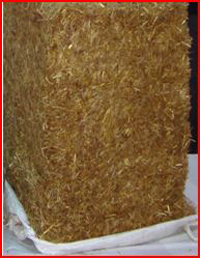
The processes of pelleting and cubing are similar in that the feeds are ground (in the case of pelleting) or chopped into small particles (in the case of cubing) before being compacted under pressure and at elevated temperatures to form pellets or small wafers up to 3 cm in diameter. The process of pelleting normally describes feeds containing high levels of cereal grain finely ground and treated with steam to produce gelatinisation of starch before the mixed feed is extruded through dies of 0.2 to 1 cm in diameter. In order to remain intact during handling and feeding out, pellets must be made out of material with the particle length less than half the diameter of the pellets. Pelleted feed is easy to handle in bulk and can be fed out automatically using tubular distribution systems. This ease of handling, the high density of the feed and the flexibility of this feeding method to deliver a complete balanced diet are attractive features. The process of pelleting comes at a reasonably high price and is only economically attractive when the costs of labour or storage are significant factors. The pelleted feeds are also very convenient for smaller scale operators not wishing to invest in mixing and storage equipment. When buying in the pelleted feeds there is also no need to maintain stocks of lots of individual ingredients covering mineral, vitamin and amino acid supplements.
The process of cubing is mainly used for hay transport and feeding. It is a process that is very popular in the United States for preparing lucerne hay for export and for feeding lucerne hay to dairy cattle and horses. It is best described as a “micro hay baler” and produces “chunks” of compressed feed approximately 3 cm x 3 cm that are easily handled using conveyor belts and mechanical shovels and have a sufficiently high density for export in container loads. This method of feed preparation has also become popular in the live animal export industry where it is well suited to limited storage and cramped on–board feeding systems.
The processes of cutting (or chaffing), cubing or pelleting can also do a lot to reduce wastage of roughage. When long hay is fed to cattle or sheep there is often wastage due to trampling and spreading the feed around. However there are additional costs in terms of feed troughs required to take advantage of the chopped, high density mixed diets and these additional expenses must be considered against the benefits. Roughages can be efficiently utilised by implementing good management practices such as use of the “waste not” feeder for round–bale hay and mobile silage carts.
Dehydration
Green forage such as alfalfa/lucerne can be preserved by dehydrating the forage at high temperature (600-1500°F) in a dehydrator for a short time (3-5 min.). It is usually done with the young growing and good quality forage. This method of forage preservation retains a maximum amount of dry matter and protein and there is no loss of leaves in the process. There is a loss of carotene (5-15%) during the process of artificial drying. Dehydrated alfalfa pellets (17% CP) are usually used as supplement to cattle rather than as primary source of roughage. These pellets are not palatable as compared to cubed or baled hay.
Chemical treatment of roughages
Tremendous amounts of fibrous crop residues such as wheat, barley and rice straws are underutilised throughout the world. During the 70s and 80s there was considerable interest in the chemical treatment of straws and other of low quality roughages to improve their quality for ruminant feeding.
The principal chemical method used to treat roughages to increase their digestibility is alkali treatment. This breaks (hydrolyses) chemical bonds and releases the digestible carbohydrates in cell walls from the indigestible lignin. Early research showed very exciting increases in the digestibility of roughages in response to treatment with sodium hydroxide. Sheep and cattle fed alkali-treated roughages showed benefits in terms of increased feed intake in addition to the expected improvements associated with higher digestibility of the roughage. Based on this early success, calcium and potassium hydroxide were investigated as alternative sources of alkali. There was also work on the use of ammonia to treat roughages, particularly from the point of view of treating straw with anhydrous ammonia, urea or, as an alternative source of ammonia, urine.
Although the treatment of low quality roughages with hydroxide is very effective as a way of increasing digestibility, intake and improving animal performance, a number of logistical, safety and environmental issues have limited the use of chemical treatment under commercial conditions.
Alkali treatment forms the basis of the wood pulping process used for paper manufacture. The effect of the alkali is to cleave internal linkages, lignin, the non–starch polysaccharides (NSP) and cellulose. Degradation of the lignin and NSP makes the cellulose more accessible for hydrolysing enzymes. During alkali treatment of fibrous material the structural NSP are also partly solubilised. The application of heat together with alkaline conditions can solubilise the lignin with formation of free phenols. Steaming at temperatures over 160°C can increase digestibility through autohydrolysis and because the lignin melts at these high temperatures.
Sodium hydroxide treatment to increase digestibility and intake of roughages
Before the 1920s, scientists had shown that boiling straws in sodium hydroxide (NaOH) solution could improve their feeding value. In Australia, Dr Roy Kellaway and colleagues at Sydney University developed practical ways of treating large quantities of cereal stubbles during the baling process. There are three major problems in using NaOH. The first is the danger to operators and the risk of being splashed with the strong NaOH solution. It is highly corrosive and particularly dangerous if it comes into contact with skin and eyes. The second issue is the high sodium level and its adverse impact on the environment. High sodium levels can also have adverse effects on the animal and there are reports of kidney damage in dairy cattle fed high levels of sodium over long periods of time. High levels of sodium can also have a negative effect on soil structure and the environment. A further problem, common to all alkali treatment processes, is the corrosion and damage to equipment.
As an alkaline agent, ammonium hydroxide is not as strong as NaOH and the gains in digestibility of roughage are generally lower. However, it has compensating benefits – the ammonia increases the availability of rumen degradable N for the rumen microbes to use to make protein and ammonia has a preservative effect inhibiting mould development during treatment.
Treatment with urea or ammonia
Many common bacteria found on plant materials have urease activity and urea is therefore rapidly degraded to carbon dioxide and ammonia if it is added to plant biomass under natural conditions. Provided there is sufficient water present, ammonium hydroxide is quickly formed.
Urea —> ammonia + water —> ammonium hydroxide
Urea is far safer to handle than ammonium hydroxide and can be applied to straw as an aqueous solution. There have been numerous studies to determine the optimum concentration of urea and the appropriate time between application and feeding the straw. It is generally agreed that around 5% urea should be used (50 kg urea per tonne of straw) and that the straw should then be covered with plastic sheeting or ensiled for at least 4 weeks prior to being used. Once the treated straw is sealed in an air-tight container or pit, it is stable for long periods.
Ammonia gas (anhydrous ammonia) can be used instead of ammonia solutions. The concentration of anhydrous ammonia required for the same effect is about 3%. Anhydrous ammonia has the advantage of easy application to large stacks of straw as a gas and is still popular in some parts of Europe where large piles of cereal straw are covered with black plastic prior to introducing gaseous ammonia from a mobile tank . It is potentially a dangerous procedure as the gas is toxic and flammable.
The methods of harvesting the roughage, chopping it and applying the urea/ammonia, and having the right facilities for storage and suitable equipment for feeding out the treated material are all critical in determining the success and attractiveness of this procedure. As it can involve large quantities of material, it is highly desirable to have highly mechanized methods for harvesting and filling the pit or silo.
Biological treatment of roughages
- Enzyme treatment: Cellulase solution is sprayed on straw at 25 mg/100 kg straw.
- Fermentation: Chopped straw is pretreated with 3-5% NAOH, and steamed at 120°C for 15 min; then fermented with bran type media cultured with cellulolytic microorganisms at 40-50°C for 2 days.
- White-rot fungi, mushrooms and other microbes: The efficient utilization of lignocellulosic straws is limited because of metabolic block caused by lignin which occurs in a range of 3 to 13%. Some of the white-rot fungi like Phanerochaete chrysosporium degrade lignin to the extent of 65-75% while other fungi like Ganoderma applanatum and Coriolus versicolor degrade over 45% of lignin in the lignocellulosic materials. Preference is given to species which degrade only lignin but not hemicelluloses.
Indo-Dutch Project on Bioconversion of Crop Residues Studies have been conducted on white-rot Basidiomycetes, often belonging to the non-toxic and edible mushrooms.
- Zadrazil process: Straw was treated with Pleurotus sp. The process has enormous losses of organic matter. It is unfit for small level operations at farmers level.
- Karnal process: It is essentially a biological treatment of ligno cellulosics in a solid substrate fermentation (SSF) system under non sterile conditions which causes a promising improvement in the enhancement of quality of straw. It is a two stage technique wherein cereal straws are pretreated with 4% urea and 40% moisture and ensiled for 30 days in the first stage and followed by second stage in which the urea treated material is mixed thoroughly with 1% single superphosphate, 0.1% calcium oxide and then moisturise to 60-65% before inoculation with 3% Coprinus fimetarius (alkalitolerant strain) culture grown on millets. The solid substrate fermentation was terminated at mycelial stage of growth of C. fimetarius. The use of urea in the first stage has many advantages. Besides, breaking the ligno-carbohydrate bonds in the treated straw, ammonia also helps in creating conducive environment (high pH), increases CP content from 3-4% to 12-14% and acts as a chemical sterilant in preventing the growth of unwanted organisms. In the second stage, the fungus traps the excess free ammonia in the urea-treated straw and synthesize amino acids. Thus there was substantial increase in the amino acid content of fungal treated straw. Considerable dry matter losses were there. However, dry matter losses were reduced from 35% to 7% by applying certain modifications.


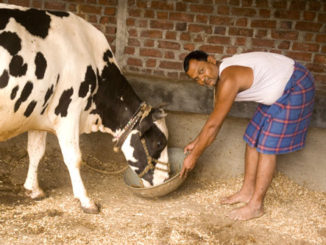
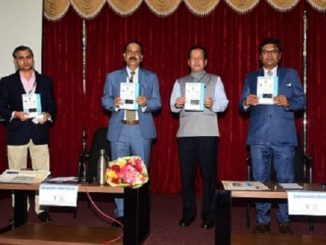
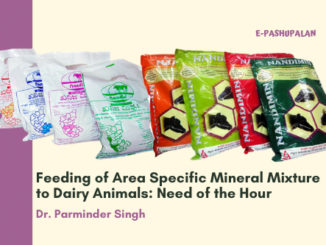

The document is important for reference